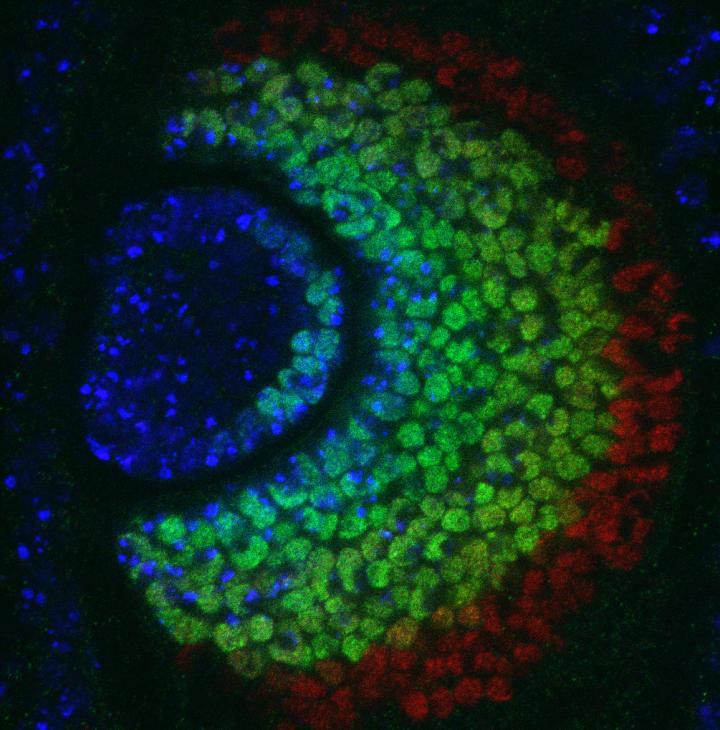

Concentric rings in a fruit fly larva's antenna result from a set of genetic control "switches" that interact early in a fly's development to generate dozens of types of specialized nerve cells for smell. The Duke researchers who made this discovery say it may help explain how a relatively small number of genes can create the dazzling array of different cell types found in human brains and the nervous systems in other animals.
Photo by Tristan Qingyun Li, Duke University
A new study sheds light on how fruit flies get their keen sense of smell.
Duke University biologist Pelin Volkan and colleagues have identified a set of genetic control switches that interact early in a fly's development to generate dozens of types of olfactory neurons, specialized nerve cells for smell.
The same gene network also plays a role in programming the fly neurons responsible for taste, the researchers report in the journal PLOS Genetics.
The findings do more than merely explain how a household pest distinguishes rotting vegetables from ripening fruit, the authors say. The research could be a key to understanding how the nervous systems of other animals — including humans, whose brains have billions of neurons — produce such a dazzling array of cell types from a modest number of genes.
Fruit flies rely on their keen sense of smell to tell the difference between good food and bad, safety and danger, potential mates and those off-limits. The tiny insects perceive this wide range of chemical cues through a diverse set of olfactory sensory neurons along their antennae. More than 2000 such neurons are organized into 50 types, each of which transmits information to a specific region of the fly's poppy seed-sized brain.
“Each neuron type detects a very specific range of odors,” Volkan said. Certain odors from fermenting fruit, for example, activate one class of neurons, and carbon dioxide activates another.
Volkan is interested in how the many types of smell neurons come to be as a fruit fly develops from egg to an adult.
Smell neurons begin as identical precursor cells, immature cells that have not yet “decided” which type of nerve cell they will become. All precursor cells have the same DNA, and how they produce one neuron type versus another was unknown.
One way to get many types of cells or proteins from the same genetic starting material is by mixing and matching different parts of one gene to produce multiple gene readouts, a phenomenon known as alternative splicing. The team's results point to another strategy, however: using the same genes in different combinations, or “combinatorial coding.”
By tweaking different fly genes and counting how many neuron types were produced as the flies matured, the team identified a network of five genes that work together like coordinated control switches to guide the precursor cells' transformation to mature neurons. The genes regulate each other's activity, interacting in unique combinations to set each precursor cell on a distinct path by turning on different olfactory receptors in each cell.
The researchers found that manipulating the network had similar effects in the legs, which flies use not only to walk but also to taste. “The same basic toolkit gives rise to diverse types of neurons in completely different tissues,” said Volkan, who is also a member of the Duke Institute for Brain Sciences.
Several of the network genes Volkan and her team identified have counterparts in humans and other vertebrates, which suggests the same basic mechanism could be at work in building the nervous system in other animals too.
###
Authors include Qingyun Li, Scott Barish, Sumie Okuwa and Abigail Maciejewski of Duke, Alicia Brandt and Corbin Jones of University of North Carolina-Chapel Hill and Dominik Reinhold of Clark University.
This research was supported by the National Science Foundation (1457690).
CITATION: “A Functionally Conserved Gene Regulatory Network Module Governing Olfactory Neuron Diversity,” Qingyun Li et al. PLOS Genetics, January 2016. DOI: 10.1371/journal.pgen.1005780












